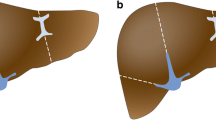Abstract
Background
Image-guided radiofrequency ablation is a well-accepted technique of interventional oncology in adults.
Objective
To evaluate the efficacy and safety of CT-guided radiofrequency ablation as a minimally invasive treatment for metastatic neoplasms in children.
Materials and methods
A total of 15 radiofrequency ablation sessions were performed in 12 children and young adults (median age 9.5; range 5–18 years) with metastatic malignancies. Seven children and young adults had secondary hepatic lesions, three had pulmonary and two had bone lesions. Radiofrequency ablation was performed under conscious sedation.
Results
The median lesion size was 1.7 cm (range 1.3–2.8 cm). The median time for ablation was 8 min (range 7–10 min). Radiofrequency procedures were technically successful in all tumors. Postablation imaging immediately after, and 1 month and 3 months after radiofrequency ablation showed total necrosis in all patients. At 6-month follow-up, three patients (all with lesion size >2 cm) had local recurrence and underwent a second radiofrequency ablation session. At 2-year follow-up no patient had recurrence of the treated tumor. Post-ablation syndrome occurred in four children. No major complication occurred.
Conclusion
CT-guided radiofrequency tumor ablation was safe and efficient for palliative treatment in our cohort of patients.



Similar content being viewed by others
References
Ye J, Shu Q, Li M et al (2008) Percutaneous radiofrequency ablation for treatment of hepatoblastoma recurrence. Pediatr Radiol 38:1021–1023
Brown SD, vanSonnenberg E (2007) Issues in imaging-guided tumor ablation in children versus adults. AJR Am J Roentgenol 189:626–632
Goldberg SN, Grassi CJ, Cardella JF et al (2009) Image-guided tumor ablation: standardization of terminology and reporting criteria. J Vasc Interv Radiol 20:S377–390
Kliegman RM, Behrman RE, Jenson HB et al (2007) Nelson textbook of pediatrics, 18th edn. Saunders Elsevier, Philadelphia
Neumann D, Berka H, Dorn U et al (2012) Follow-up of thirty-three computed-tomography-guided percutaneous radiofrequency thermoablations of osteoid osteoma. Int Orthop 36:811–815
Rybak LD, Rosenthal DI, Wittig JC (2009) Chondroblastoma: radiofrequency ablation — alternative to surgical resection in selected cases. Radiology 251:599–604
Brown SD, Vansonnenberg E, Morrison PR et al (2005) CT-guided radiofrequency ablation of pediatric Wilms tumor in a solitary kidney. Pediatr Radiol 35:923–928
Hoffer FA (2011) Interventional oncology: the future. Pediatr Radiol 41:S201–206
Lencioni R, Crocetti L (2007) Radiofrequency ablation of liver cancer. Tech Vasc Interv Radiol 10:38–46
Hoffer FA, Campos A, Xiong X et al (2007) Core body temperature regulation of pediatric patients during radiofrequency ablation. Pediatr Radiol 37:297–300
Thanos L, Mylona S, Ptohis N et al (2009) Percutaneous radiofrequency thermal ablation in the management of lung tumors. Presentation of clinical experience on a series of 35 patients. Diagn Interv Radiol 15:290–296
Livraghi T, Solbiati L, Meloni MF et al (2003) Treatment of focal liver tumors with percutaneous radio-frequency ablation: complications encountered in a multicenter study. Radiology 226:441–451
Burgoyne LL, Pereiras LA, Laningham F et al (2008) Near-fatal acute bronchovenous fistula in a child undergoing radiofrequency ablation of a metastatic lung tumor. Paediatr Anaesth 18:1131–1133
Hoffer FA, Daw NC, Xiong X et al (2009) A phase 1/pilot study of radiofrequency ablation for the treatment of recurrent pediatric solid tumors. Cancer 115:1328–1337
Llovet JM, Vilana R, Brú C et al (2001) Increased risk of tumor seeding after percutaneous radiofrequency ablation for single hepatocellular carcinoma. Hepatology 33:1124–1129
De Baère T, Risse O, Kuoch V et al (2003) Adverse events during radiofrequency treatment of 582 hepatic tumors. AJR Am J Roentgenol 181:695–700
Richtmyer JM (2006) Electrosurgical burns in pediatric patients undergoing liver resection with saline-enhanced radiofrequency technology. AORN J 83:658–664
Clark TW (2003) Percutaneous chemical ablation of desmoid tumors. J Vasc Interv Radiol 14:629–634
Conflicts of interest
None.
Author information
Authors and Affiliations
Corresponding author
Rights and permissions
About this article
Cite this article
Botsa, E., Poulou, L.S., Koutsogiannis, I. et al. CT-guided radiofrequency tumor ablation in children. Pediatr Radiol 44, 1421–1425 (2014). https://doi.org/10.1007/s00247-014-3008-y
Received:
Revised:
Accepted:
Published:
Issue Date:
DOI: https://doi.org/10.1007/s00247-014-3008-y




